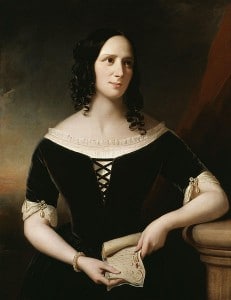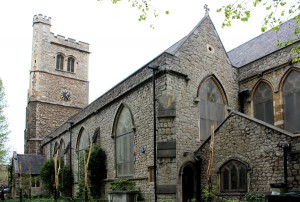
I’m writing this article to banish the myth that Anne Boleyn had a stepmother because, for some reason, I have received three emails in the past two weeks all asking me about Elizabeth Boleyn’s apparent death in 1512. All three emails referred to novels which give Anne a stepmother, for example Jean Plaidy’s “Lady in the Tower” which has Elizabeth Boleyn dying before Anne goes to France and Anne talking affectionately of her stepmother.
“But those are novels!”, I hear you say, BUT this myth actually has its roots in history books. Agnes Strickland, the Victorian author, seems to have been the first to write about Anne having a stepmother. In “Lives of the Queens of England”, Strickland writes:
“The first misfortune that befel Anne was the loss of her mother, Lady Boleyn, who died in the year 1512, of puerperal fever… Sir Thomas Boleyn married again; at what period of his life we have no record, but it is certain that Anne’s step-mother was a Norfolk woman of humble origin.”1
This “fact” is repeated in Hester W. Chapman’s 1974 biography of Anne Boleyn,2 so it is likely that Chapman used Strickland as her source and novelists have then used Strickland or Chapman. Joanna Denny3 also writes that “it is said that Thomas remarried, giving hi children a stepmother, a new Lady Boleyn”, although she does comment that there are “conflicting dates” given for Elizabeth’s date of death. Strickland cites her sources for Elizabeth’s death in 1512 and Thomas Boleyn’s second marriage as “Thoms Traditions, Camden Society” and “Howard memorials by Mr Howard of Corby”, so I looked them up and found “Annecdotes and Traditions illustrative of Early English History and Literature” edited by William J. Thoms on Google Books. In that book, I found Strickland’s reference, which is a note by Thoms on an anecdote told by Sir Nicholas L’Estrange about Elizabeth I. L’Estrange’s anecdote is:
“One begg’d of Queene Elizabeth, and pretended kindred and alliance, but there was no such relation. “Friend,” says she, “grant it be so, do’st thinke I am bound to keepe all my kindred? Why that’s the way to make me a beggar.” L’Estranye, No. 124. Mr. Derham.”4
Thoms notes “Queen Elizabeth had numerous maternal relations, and many of them among the inferior gentry particularly in Norfolk, an inconvenience which arose from her father having selected for his second consort a subject of no very elevated extraction, whilst the blood of the Boleynes was widely diffused by the intermarriages of numerous junior branches.”5
As Philip Sergeant points out in his “The Life of Anne Boleyn”,6 Strickland seems to have misread Thoms’ note. He is talking about Queen Elizabeth’s father’s second marriage, i.e. Henry VIII’s marriage to Anne Boleyn, NOT Thomas Boleyn’s second marriage.
I was unable to obtain a copy of “Indication of Memorials, Monuments, Paintings and Engravings of Persons of the Howard Family” by Henry Howard but Philip Sergeant discusses the record on Elizabeth Boleyn in his book.7 In this privately printed memorial of the Howard family, Howard apparently records Elizabeth Howard, wife of Thomas Boleyn, as dying of puerperal fever on 14th December 1512 and being buried at Lambeth. Sergeant searched for a funeral certificate but was unable to find one but notes that J. Nichols’s “History of the Parish of Lambeth” (1786) stated that there used to be a brass plate at St Mary’s Church, Lambeth, which is now a garden museum, which was inscribed “Here lyeth the Lady Elizabeth Howard, some time Countess of Wiltshire”. I’ve got a copy of this book, which is actually published by Nichols but written by Thomas Allen, and I cannot find any mention of Elizabeth’s brass. I did, however, find mention of the brass plate in John Aubrey’s “The Natural History and Antiquities of the County of Surrey”.8 No date of death was mentioned but we know for certain that Lady Wiltshire, Thomas Boleyn’s wife, was buried in the Howard aisle of St Mary’s Church, Lambeth on 7th April 1538 from a letter written by John Hussey to Lady Lisle on 9th April 1538:
“My lady Wiltshire was buried at Lamehithe on the 7th… She was conveyed from a house beside Baynard’s Castle by barge to Lambeth with torches burning and four baneys (banners?) set out of all quarters of the barge, which was covered with black and a white cross.”9
This Lady Wiltshire must have been a Howard woman to be interred with other Howard women in the Howard aisle of the church, rather than being some other “Norfolk woman of humble origin”. She must surely have been Elizabeth Boleyn (nee Howard).
So why the confusion?
Sergeant couldn’t understand the confusion and could not find another Elizabeth Howard who died in 1512, but there is a Howard woman who died in December 1512 and she was Elizabeth’s sister. Muriel Howard, wife of Sir Thomas Knyvett, died in childbirth or shortly after childbirth in December 1512 and was buried at Lambeth. Her will was proved on 12 January 1513.10 11 12 She must be the Howard woman that Henry Howard was referring to in his memorials on the family; the sisters have been confused.
Unfortunately, once a “fact” is written in a book, or these days in a blog post or online somewhere, it quickly spreads. Elizabeth Boleyn’s mythical early death is in many novels, so people will continue to believe that Anne Boleyn had a stepmother. But, the mother who chaperoned Anne while Henry VIII courted her and the mother whose health Anne was so worried about when Anne was arrested and imprisoned in the Tower was her real biological mother, she was Elizabeth Howard.

Notes and Sources
- Strickland, Agnes (1864) Lives of the Queens of England: Volume II, p178
- Chapman, Hester W. (1974) Anne Boleyn, p19
- Denny, Joanna (2004) Anne Boleyn, p29
- ed. Thoms, William J. (1839) Annecdotes and Traditions illustrative of Early English History and Literature, p16
- Ibid.
- Sergeant, Philip W. The Life of Anne Boleyn, Appendix C
- Ibid.
- Aubrey, John. The Natural History and Antiquities of the County of Surrey: Begun in the Year 1673, Vol V
- LP xiii part 1 717
- Gunn, S. J. ‘Knyvet, Sir Thomas (c.1485–1512)’, Oxford Dictionary of National Biography, Oxford University Press, 2004
- “Muriel Howard” at http://histfam.familysearch.org/getperson.php?personID=I17044&tree=Nixon
- Kate Emerson’s A Who’s Who of Tudor Women